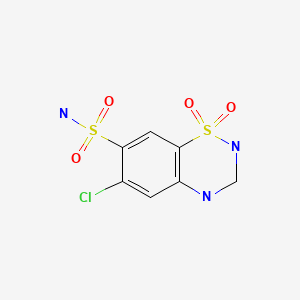Attribution Statement: LactMed is a registered trademark of the U.S. Department of Health and Human Services.
NCBI Bookshelf. A service of the National Library of Medicine, National Institutes of Health.
Drugs and Lactation Database (LactMed®) [Internet]. Bethesda (MD): National Institute of Child Health and Human Development; 2006-.
CASRN: 58-93-5

Drug Levels and Effects
Summary of Use during Lactation
Hydrochlorothiazide doses of 50 mg daily or less are acceptable during lactation. Intense diuresis with large doses may decrease breastmilk production.
Drug Levels
Maternal Levels. In a mother who was 28 days postpartum, hydrochlorothiazide reached a peak milk level of about 275 mcg/L at about 3 hours after a 50 mg oral dose. The infant received a daily dosage of about 2% of the mother's weight-adjusted dose.[1]
Infant Levels. Hydrochlorothiazide was not detectable (<20 mcg/L) in the serum of a 28-day-old breastfed infant at about 2 and 11 hours after the mother's dose.[1]
Effects in Breastfed Infants
No electrolyte abnormalities were noted in one 28-day-old infant who was breastfed since birth while his mother was taking oral hydrochlorothiazide 50 mg daily.[1]
Effects on Lactation and Breastmilk
Hydrochlorothiazide in dosages of 100 mg daily in the morning and 50 mg in the afternoon or 50 mg twice daily have been used to successfully to suppress lactation at various times postpartum.[2,3] Intense diuresis with thiazides and thiazide-like diuretics, fluid restriction and breast binding have been used to suppress postpartum lactation.[2,4,5] The added contribution of the diuretic to these measures, which are effective in suppressing lactation, has not been studied. There are no data on the effects of diuretics on established, ongoing lactation.
Alternate Drugs to Consider
References
- 1.
- Miller ME, Cohn RD, Burghart PH. Hydrochlorothiazide disposition in a mother and her breast-fed infant. J Pediatr 1982;101:789-91. [PubMed: 7131161]
- 2.
- Stout G. Suppression of lactation. Br Med J 1962;1:1150.
- 3.
- Reisfield DR, Paret FL. Value of a diuretic in suppressing breast engorgement. J Med Soc N J 1966;63:458-61. [PubMed: 5341754]
- 4.
- Healy M. Suppressing lactation with oral diuretics. Lancet 1961;277(7190):1353-4. doi: 10.1016/S0140-6736(61)90289-6 [CrossRef]
- 5.
- Reiher KH. Suppression of lactation by stimulation of diuresis. Zentralbl Gynakol 1963;85:188-90. [PubMed: 13973786]
Substance Identification
Substance Name
Hydrochlorothiazide
CAS Registry Number
58-93-5
Drug Class
Breast Feeding
Lactation
Milk, Human
Antihypertensive Agents
Thiazide Diuretics
Disclaimer: Information presented in this database is not meant as a substitute for professional judgment. You should consult your healthcare provider for breastfeeding advice related to your particular situation. The U.S. government does not warrant or assume any liability or responsibility for the accuracy or completeness of the information on this Site.
- User and Medical Advice Disclaimer
- Drugs and Lactation Database (LactMed) - Record Format
- LactMed - Database Creation and Peer Review Process
- Fact Sheet. Drugs and Lactation Database (LactMed)
- Drugs and Lactation Database (LactMed) - Glossary
- LactMed Selected References
- Drugs and Lactation Database (LactMed) - About Dietary Supplements
- Breastfeeding Links
- PubChem SubstanceRelated PubChem Substances
- PubMedLinks to PubMed
- Toxicology and Carcinogenesis Studies of Hydrochlorothiazide (CAS No. 58-93-5) in F344/N Rats and B6C3F1 Mice (Feed Studies).[Natl Toxicol Program Tech Rep ...]Toxicology and Carcinogenesis Studies of Hydrochlorothiazide (CAS No. 58-93-5) in F344/N Rats and B6C3F1 Mice (Feed Studies).National Toxicology Program. Natl Toxicol Program Tech Rep Ser. 1989 Jul; 357:1-194.
- Review Chlorothiazide.[Drugs and Lactation Database (...]Review Chlorothiazide.. Drugs and Lactation Database (LactMed®). 2006
- Review Methyclothiazide.[Drugs and Lactation Database (...]Review Methyclothiazide.. Drugs and Lactation Database (LactMed®). 2006
- Review Trichlormethiazide.[Drugs and Lactation Database (...]Review Trichlormethiazide.. Drugs and Lactation Database (LactMed®). 2006
- Review Hydroflumethiazide.[Drugs and Lactation Database (...]Review Hydroflumethiazide.. Drugs and Lactation Database (LactMed®). 2006
- Hydrochlorothiazide - Drugs and Lactation Database (LactMed®)Hydrochlorothiazide - Drugs and Lactation Database (LactMed®)
Your browsing activity is empty.
Activity recording is turned off.
See more...
